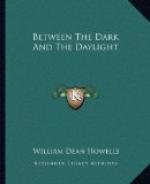“I don’t remember hearing of any case of this kind before. Thought-transference is a sufficiently ascertained phenomenon—the insistence of a conscious mind upon a certain fact until it penetrates the unconscious mind of another and is adopted as its own. But in the dream state the mind seems passive, and becomes the prey of this or that self-suggestion, without the power of imparting it to another dreaming mind. Yet here we have positive proof of such an effect. It appears that the victim of a particularly terrific nightmare was able to share its horrors—or rather unable not to share them—with a whole sleeping-car full of people whose brains helplessly took up the same theme, and dreamed it, as we may say, to the same conclusions. I said proof, but of course we can’t accept a single instance as establishing a scientific certainty. I don’t question the veracity of Mr.—”
“Newton,” the stranger suggested.
“Newton’s experience,” Wanhope continued, “but we must wait for a good many cases of the kind before we can accept what I may call metaphantasmia as being equally established with thought-transference. If we could it would throw light upon a whole series of most curious phenomena, as, for instance, the privity of a person dreamed about to the incident created by the dreamer.”
“That would be rather dreadful, wouldn’t it?” I ventured. “We do dream such scandalous, such compromising things about people.”
“All that,” Wanhope gently insisted, “could have nothing to do with the fact. That alone is to be considered in an inquiry of the kind. One is never obliged to tell one’s dreams. I wonder”—he turned to the stranger, who sat absently staring into the fire—“if you happened to speak to your friend about his nightmare in the morning, and whether he was by any chance aware of the participation of the others in it?”
“I certainly spoke to him pretty plainly when we got into New York.”
“And what did he say?”
“He said he had never slept better in his life, and he couldn’t remember having a trace of nightmare. He said he heard me groaning at one time, but I stopped just as he woke, and so he didn’t rouse me as he thought of doing. It was at Hartford, and he went to sleep again, and slept through without a break.”
“And what was your conclusion from that?” Wanhope asked.
“That he was lying, I should say,” Rulledge replied for the stranger.
Wanhope still waited, and the stranger said, “I suppose one conclusion might be that I had dreamed the whole thing myself.”
“Then you wish me to infer,” the psychologist pursued, “that the entire incident was a figment of your sleeping brain? That there was no sort of sleeping thought-transference, no metaphantasmia, no—Excuse me. Do you remember verifying your impression of being between Worcester and Springfield when the affair occurred, by looking at your watch, for instance?”




